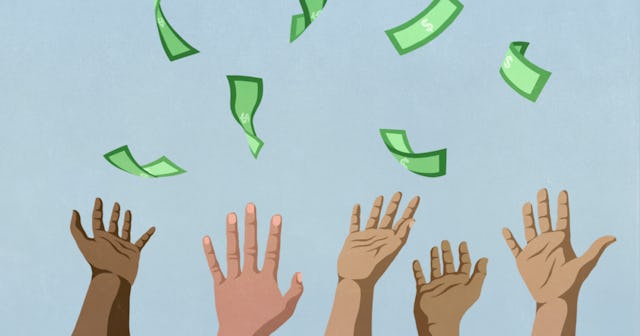A Breakdown Of The COVID Relief Bill (& How To Know If You Qualify For The Child Tax Credit)

On Thursday, March 11th, President Biden signed the $1.9 trillion coronavirus relief bill known as the American Rescue Plan. The bill had been passed by the Senate on March 6th after 24 long hours of debate, and the House of Representatives followed suit on Wednesday, March 10th. The House had already passed its own version of the bill in February, but the Senate amended the bill to adhere to Senate budget rules, and to earn the support of more moderate Democrats who wanted to lower the income cutoff in order to target lower-income families.
The American Rescue Plan devotes funds to vaccines, education, and to American families, small businesses, and workers. But what specifically does it mean for parents? Here’s what parents need to know about how the latest coronavirus relief package may impact them:
Payments To Individuals
Individuals earning $75,000 or less and couples earning $150,000 or less will receive a payment of $1,400 per person. Individuals earning between $75,000 and $80,000 and couples earning between $150,000 and $160,000 will receive a lesser amount, and those earning above those thresholds will receive nothing.
Payment Per Child
Individuals earning $75,000 or less and couples earning $150,000 or less will receive an additional payment of $1,400 per child or other dependent claimed on their tax return. The same income cutoffs as above apply here as well.
Extended Unemployment Benefits
According to the bill passed by the Senate, unemployment payment supplements will hold at $300 per week, which is $100 less per week than the previous bill that was passed by the House. These benefits are set to stay in effect through September 6.
For tax purposes, you should know that the first $10,200 you receive in unemployment benefits are nontaxable if your combined household income is below $150,000.
Expanded Child Tax Credit
The child tax credit will be increased from approximately $2,000 under current law to $3,000 for children ages 6 to 17 and to $3,600 for children under 6, proposed to be distributed in monthly installments. This works out to $250 per month for older kids and $300 per month for younger kids.
You will be eligible for the full child tax credit if you are an individual making $75,000 a year or less, or if you are a couple making $150,000 or less. However, even if you make more than those amounts, you will still be eligible for a portion of this credit.
For every additional $1000 of adjusted gross income you earn, your child tax credit will be reduced by $50. However, if you are a family who earns too much to qualify for this additional child tax credit, you can still claim a $2000 credit, which is available to individuals who make up to $200,000 and joint taxpayers making up to $400,000.
Another important change to the child tax credit? You don’t have to be employed to receive it. Previously, you had to make at least $2500 a year to receive this credit, but not anymore. Any family can receive it — employed or not.
Many Democrats, and Mitt Romney with his streamlined child allowance, are looking to extend these benefits, possibly permanently.
Money For Education
$128 billion is slated for grants to state educational agencies, 90% of which is meant to go to local educational institutions. $15 billion will go to the Child Care & Development Block Grant program in support of child care facilities, with an emphasis in high-need areas.
Another provision will make it so student loan forgiveness passed between Dec. 31, 2020, and Jan. 1, 2026 will be tax-free as opposed to treated as taxable income.
Assistance For Low-Income Families
The bill sets aside $4.5 billion to support the Low Income Home Energy Assistance Program, or LIHEAP, to assist families in paying their heating and cooling bills. Another provision permits the agriculture secretary to temporarily boost the value of cash vouchers for WIC up to $35 per month.
Paycheck Protection
$7.25 billion is allocated for small business loans, also known as the Paycheck Protection Program, or PPP. If you run a small business or are self-employed, you may want to apply, especially since loans taken out under this program, as long as funds are used for qualifying expenses, can be 100% forgiven.
Rental Assistance
$25 billion is slated to go to emergency rental assistance, including emergency housing vouchers for those experiencing homelessness and for victims of domestic violence or human trafficking.
Funding Coronavirus Logistics
The CDC will receive $7.5 billion to efficiently distribute COVID-19 vaccines. $46 billion will go to diagnosis and contact tracing, and another $2 billion will go to providing needed testing supplies and PPE.
As more and more people get vaccinated, the end finally feels like it’s in sight. Keep being smart about masking up and social distancing, and hopefully some of these provisions passed in this latest relief bill will provide some much-needed relief to struggling Americans as we inch closer and closer toward normalcy.
This article was originally published on